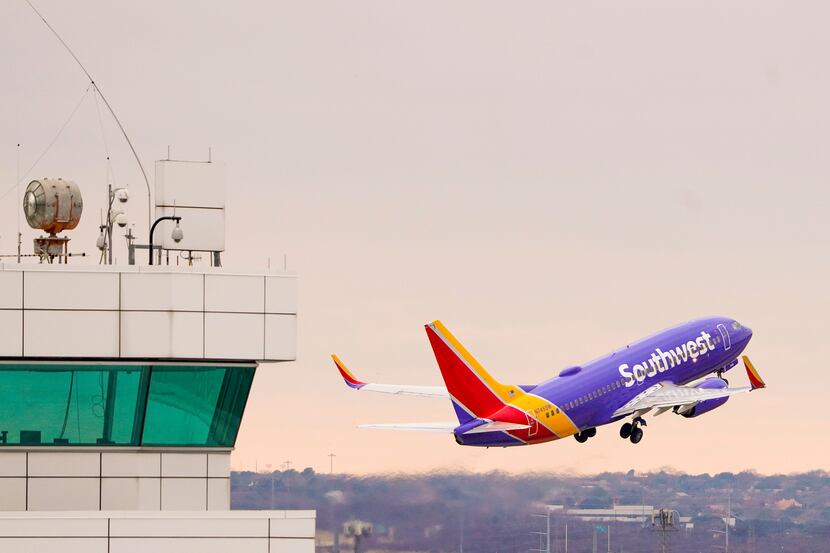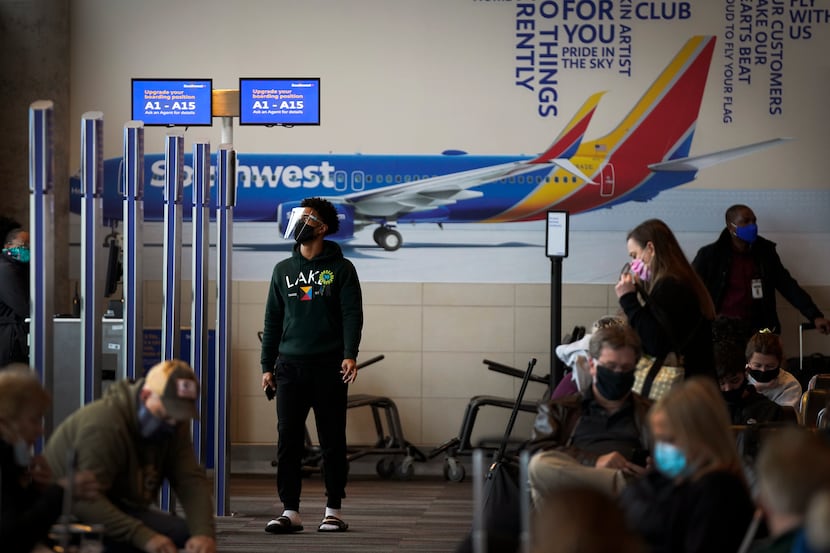The COVID-19 pandemic has turned historically cautious Southwest Airlines into a predator in the airline world.
The Dallas-based airline — known for its stubborn adherence to a “bags fly free” policy and for ignoring some of the nation’s biggest airports to focus on lower-cost alternatives — has suddenly become the first-shot aggressor in a coming war for control of the nation’s skies.
The airline has added 11 new destinations to its route map since the beginning of October, often soaring into the stronghold hubs of its competitors, including American Airlines. Despite a coronavirus-weakened balance sheet, the carrier’s years of financial prudence and focus on domestic flying is now putting it in a position to grow while others shrink and hold on for dear life.
During a year when airlines shrunk for survival, Southwest gained a larger share of the market by cutting less, dropping its number of completed flights by 34% in 2020 compared with 2019. American decreased its flight total by 42%, Delta by 43% and United by 48%.
Southwest ended the year as the world’s largest mainline carrier by the number of flights completed, not including regional carriers like American Eagle and Skywest, according to global flight data firm Cirium. It completed 669,000 flights in 2020, almost 50% more than second-place American.
“Before this COVID-19 pandemic, our biggest limitation was the [Boeing 737] Max grounding,” Southwest Airlines chief operating officer Mike Van de Ven said in an interview. “We have the ability now to grow this airline and we didn’t have the access to airplanes to do that before.
“The demand for our service was outstripping our ability. It’s reset the runway.”
Even though Southwest completed fewer overall flights in 2020 than the year before and the carrier’s place atop the list is likely to be short-lived, the company’s leaders have put a plan in place that could narrow the gap for years to come.
Southwest has long been content to be the country’s fourth-largest air travel provider, but that may be changing.
“There isn’t always an opportunity to go into some of these markets and take a share from your competitors,” said Matt Lee, an airline industry analyst with Landrum & Brown in Cincinnati. “They want to establish a foothold in places they are not in, and there isn’t a better time to do it if you have the resources.”
But Southwest’s plan is one borne somewhat out of panic, even if years of careful planning factor into the decisions. Revenue is expected to be down at least 60% for the three months that ended the year. On average, planes were expected to be more than a third empty, even after dropping an empty-middle-seat strategy to assuage customers.
“They have been successful in their core business strategy for a long time, so when you deviate, there are risks,” said Jeff Windau, an airline industry analyst for Edward Jones. “You are going to draw a competitive response. They are going to take more notice. It’s a competitive market.”
New destinations, new risks
Southwest’s plans have intruded directly into crucial home turf for its largest competitors.
In September, the airline said it would fly to Miami International Airport after decades of favoring Fort Lauderdale-Hollywood International 27 miles to the north. Miami is a key hub for American Airlines, which uses it as its gateway to Latin and South America.
Then, in October, Southwest announced plans to fly to Houston’s George Bush Intercontinental and Chicago O’Hare. Chicago Midway Airport and Houston Hobby Airport are already two of the busiest airports in Southwest’s system. Houston Intercontinental is also a major hub for United Airlines. Chicago O’Hare is the hometown hub for United, too, and a major hub for Fort Worth-based American Airlines.
Southwest isn’t simply throwing darts at a map when it picks new locations. The airline industry is rife with information about where customers are flying, where they live and who is willing to drive farther to an airport for lower fares or their preferred airline, said Henry Harteveldt, a travel industry analyst with Atmosphere Research Group.
Even though Southwest CEO Gary Kelly said the initial presence in places such as Miami will be small, it should be able to pull customers who weren’t willing to drive north to Fort Lauderdale, or in Houston, across town to Houston Hobby.
Kelly said in September that the strategy is to use the company’s underused airplanes and crew members to bring in more revenue during the pandemic. But he also said the company doesn’t plan to ditch these destinations as soon as post-coronavirus demand returns.
Southwest also is adding warm-weather and beach destinations in Sarasota, Fla., and Palm Springs, Calif. In Mississippi, Jackson will be the airline’s second location in the state.
Last month, Southwest laid out plans to start flying to the California cities of Santa Barbara and Fresno. Southwest has considered California a stronghold for decades and has long pushed to be the most populous state’s most popular carrier.

A trio of new destinations in Colorado, including two seasonal ski destinations, show even bolder plans to take hold on the Rocky Mountain State, even though United also has a growing hub in Denver.
Southwest is hiring contractors to work in many of these locations, making it easier to pull out or change operations depending on demand.
Many of the new destinations fly in the face of Southwest’s long-running strategy of growing outside the continental United States. Southwest’s expansion plan has been focused on beach destinations in Mexico, Hawaii and the Caribbean. That allowed the historically U.S.-centric carrier to grow outside the U.S. using its all-Boeing 737 fleet.
The pandemic has put that expansion plan on hold. Hawaiian leaders blocked travel by most tourists in March. International travel restrictions stopped tourists from going to many of those places, too, and travelers grew skeptical of flying to other countries during the pandemic.
That forced Southwest to find a new strategy, Windau said.
“I think it’s an evolution in their thought process and their business model,” he said. “When you are a smaller company, growth is easier to come by. But now it won’t be quite as easy to grow, and there won’t be as many easy victories.”
‘Hope is not a strategy’
Southwest isn’t the only airline to expand to new destinations during the pandemic. United has added Gulf Coast locations, which have been a haven in the social distancing era. Frontier, JetBlue and Alaska have all tried to take advantage of the pandemic’s downturn with new service.
But few have the financial firepower to do what Southwest is doing, said Jon Jager, a former Southwest Airlines network planner and an analyst with Cirium, the global airline data company.
Southwest has about $35 billion in total debt, including aircraft payments. That compares to about $66 billion at American. Southwest has $13.2 billion in cash and easily liquidated assets, along with a lower daily cash burn — about $10 million — than other major airlines.
Southwest also was uniquely positioned for this falloff in demand. It has always relied more heavily on flights within the United States. International flights were a profit source for legacy airlines, but international travel collapsed and isn’t expected to recover for years.

Without expanding in the U.S., Southwest would have been stuck with dozens of unused planes and thousands of underutilized workers while losing money every day.
Jon Weaks, who just finished a two-year term as head of the Southwest Airlines Pilots Association, said it’s good to see the company try new approaches instead of giving in to the downturn.
“Hope is not a strategy, but that’s what our models are telling us right now,” Weaks said. “It’s good to see them trying something new.”
Van de Ven, Southwest’s chief operating officer, said the new destinations are locations the carrier long considered.
“We had these ideas about city expansion opportunities that we wanted to do, and this gives us the environment to do that,” he said.

